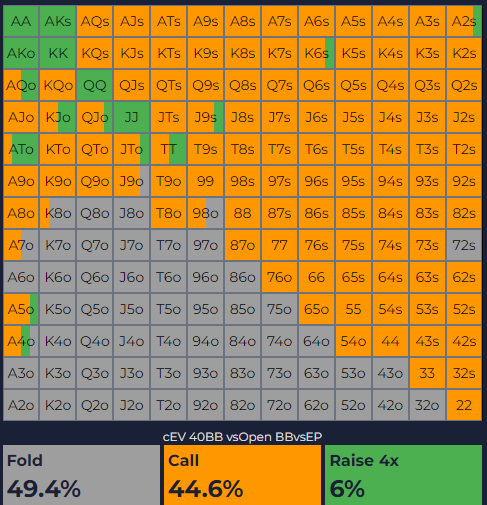OTB #040: 3 Preflop Strategies to Improve Your Win Rate in the Big Blind
- Gareth James
- Apr 6, 2024
- 3 min read
Updated: Apr 10

If you always folded in the Big Blind, your win rate would be -100bb/100 because you're forced to put out 1bb every time you're in this position.
Obviously we can improve on that, but by how much?
I recently looked at the bb/100 win rates from MonkerSolver sims to see what was possible:
You should expect to achieve higher win rates than this because you're not playing against a simulation - you're playing against humans who will make more mistakes than a solver and play worse both preflop and postflop.
Today I want to show you 3 adjustments to make to your preflop strategy to improve your win rate in the Big Blind.
Let's dive in...
1. Attack Small Blind limps more
When it folds to the Small Blind and they limp, you should raise roughly 40-45% of the time in the Big Blind.
You don't want to let the Small Blind see a flop for such a little price too often.
Here are the raising and jamming frequencies in the Big Blind facing a Small Blind limp at the different stack depths:
You can check your BB vs SB limp stat in your own database. Here's the custom stat for PokerTacker 4: https://www.pokertracker.com/custom/download/1695/raise_with_sb_limper_in_bb.pt4stat
At 100bb this range will be made up of value hands at the top and will include a decent chunk of suited connectors and gappers that can call a Small Blind 3-bet:
When you get to 30bb, you'll see how those suited hands are replaced by a lot more offsuit hands:
At 30bb the range is more polarised because the SB can limp/jam.
2. Fold more facing a raise and a call
When EP opens at 40bb, you can defend quite wide in the Big Blind, continuing with almost all suited hands, all offsuit broadways and then some offsuited connectors, Ax and 9x hands too:
If EP opens and MP calls, you're getting a much better price on a call, but you now have to realise your equity out of position against two players, both of whom have strong ranges.
The biggest mistake I see in this spot is thinking that you can call even more hands because the price you're being laid is better.
That's not true.
You now have to defend a lot tighter, with a lot of suited hands folding and many offsuit Ax hands now hitting the muck. ATo, KTo and JTo are now break-even continues:
I get my students to use Preflop Dojo to study and drill these spots. Other programs are available including DTO, GTO Wizard, Preflop Academy and Range Trainer Pro.
3. 3-bet more aggressively against late position opens
Another big leak I see is not playing aggressively enough from the Big Blind facing late position raises.
Here are the 3-bet frequencies vs a CO open at the different stack depths:
And here are the 3-bet frequencies vs a BTN open:
Again, you can check your 3-bet frequencies in your database and compare them to these stats. Make sure you filter for "vs CO open" and "vs BTN open".
At 100bb, you can 3-bet the obvious value hands together with some suited connectors and the less obvious suited gappers:
At 30bb it no longer makes sense to 3-bet the suited connectors and instead you should still 3-bet the best hands for value and then introduce some bluffs. The 3-betting range is a lot more polarised because your opponent can now 4-bet jam in response.
You can also add some 3-bet jams.
Summary
You're supposed to lose in the Big Blind. But there are many things you can do to make sure your win rate is higher than -100bb/100.
Here are 3 adjustments to start:
1. Attack Small Blind limps more
2. Fold more facing a raise and a call
3. 3-bet more aggressively against late position opens
That's all for this week.
See you next time.











Comments